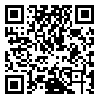Volume 8, Issue 1 (February 2021)
Avicenna J Neuro Psycho Physiology 2021, 8(1): 25-32 |
Back to browse issues page
1- Ph.D. Student, Department of Psychology, Science and Research Branch, Islamic Azad University, Tehran, Iran
2- Professor, Department of Psychology, Allameh Tabataba'i University, Tehran, Iran , Borjali@atu.ac.ir
3- Associate Professor, Department of Psychology, Science and Research Branch, Islamic Azad University, Tehran, Iran
2- Professor, Department of Psychology, Allameh Tabataba'i University, Tehran, Iran , Borjali@atu.ac.ir
3- Associate Professor, Department of Psychology, Science and Research Branch, Islamic Azad University, Tehran, Iran
Abstract: (1270 Views)
Background and objective: Unhealthy eating behavior is one of the four major risk factors for diseases. This study was conducted to model the prediction of eating behavior based on anxiety mediated attachment styles.
Materials and Methods: This correlational research was carried out based on a path analysis approach. The statistical population (n=461) included all high school female students in Tehran, Iran, in the school year of 2018-19, who were selected using the cluster sampling method. The required data were collected using the Attachment Styles Questionnaire, Spielberger Anxiety Inventory, and Eating Behavior Questionnaire. The gathered data were analyzed by path analysis based on regression equations in LISREL software (version 8.80).
Results: Based on the findings, secure, ambivalent, and avoidant attachment could influence students' eating behavior both directly and indirectly. It was also revealed that state anxiety (β=0.24) and trait (β=0.34) could directly increase unhealthy eating behavior in the samples (β=0.41). Model fit indices showed that the presented paths could explain the data well.
Conclusions: It can be concluded that a secure attachment style reduced unhealthy eating behavior by reducing anxiety. Moreover, avoidant and ambivalent attachment styles increased anxiety and resulted in unhealthy eating behavior.
Materials and Methods: This correlational research was carried out based on a path analysis approach. The statistical population (n=461) included all high school female students in Tehran, Iran, in the school year of 2018-19, who were selected using the cluster sampling method. The required data were collected using the Attachment Styles Questionnaire, Spielberger Anxiety Inventory, and Eating Behavior Questionnaire. The gathered data were analyzed by path analysis based on regression equations in LISREL software (version 8.80).
Results: Based on the findings, secure, ambivalent, and avoidant attachment could influence students' eating behavior both directly and indirectly. It was also revealed that state anxiety (β=0.24) and trait (β=0.34) could directly increase unhealthy eating behavior in the samples (β=0.41). Model fit indices showed that the presented paths could explain the data well.
Conclusions: It can be concluded that a secure attachment style reduced unhealthy eating behavior by reducing anxiety. Moreover, avoidant and ambivalent attachment styles increased anxiety and resulted in unhealthy eating behavior.
Article Type: Research Article |
Subject:
Clinical Psychology
Received: 2020/05/26 | Accepted: 2020/07/14 | Published: 2021/02/2
Received: 2020/05/26 | Accepted: 2020/07/14 | Published: 2021/02/2
| Rights and permissions | |
 |
This work is licensed under a Creative Commons Attribution-NonCommercial 4.0 International License. |




